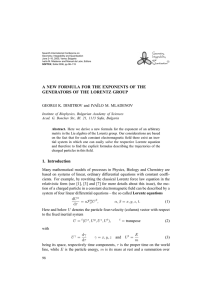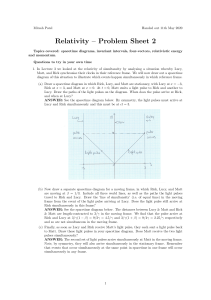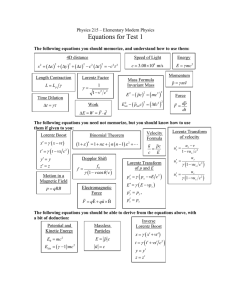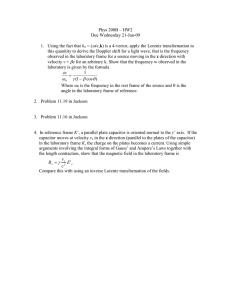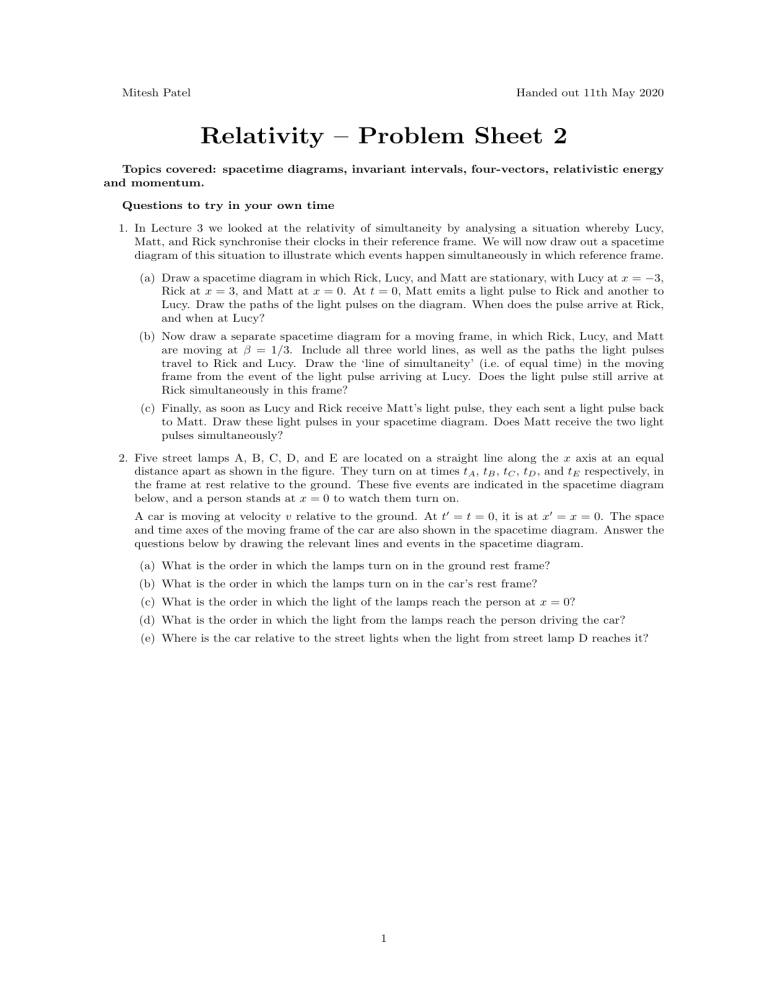
Mitesh Patel Handed out 11th May 2020 Relativity – Problem Sheet 2 Topics covered: spacetime diagrams, invariant intervals, four-vectors, relativistic energy and momentum. Questions to try in your own time 1. In Lecture 3 we looked at the relativity of simultaneity by analysing a situation whereby Lucy, Matt, and Rick synchronise their clocks in their reference frame. We will now draw out a spacetime diagram of this situation to illustrate which events happen simultaneously in which reference frame. (a) Draw a spacetime diagram in which Rick, Lucy, and Matt are stationary, with Lucy at x = 3, Rick at x = 3, and Matt at x = 0. At t = 0, Matt emits a light pulse to Rick and another to Lucy. Draw the paths of the light pulses on the diagram. When does the pulse arrive at Rick, and when at Lucy? (b) Now draw a separate spacetime diagram for a moving frame, in which Rick, Lucy, and Matt are moving at = 1/3. Include all three world lines, as well as the paths the light pulses travel to Rick and Lucy. Draw the ‘line of simultaneity’ (i.e. of equal time) in the moving frame from the event of the light pulse arriving at Lucy. Does the light pulse still arrive at Rick simultaneously in this frame? (c) Finally, as soon as Lucy and Rick receive Matt’s light pulse, they each sent a light pulse back to Matt. Draw these light pulses in your spacetime diagram. Does Matt receive the two light pulses simultaneously? 2. Five street lamps A, B, C, D, and E are located on a straight line along the x axis at an equal distance apart as shown in the figure. They turn on at times tA , tB , tC , tD , and tE respectively, in the frame at rest relative to the ground. These five events are indicated in the spacetime diagram below, and a person stands at x = 0 to watch them turn on. A car is moving at velocity v relative to the ground. At t0 = t = 0, it is at x0 = x = 0. The space and time axes of the moving frame of the car are also shown in the spacetime diagram. Answer the questions below by drawing the relevant lines and events in the spacetime diagram. (a) What is the order in which the lamps turn on in the ground rest frame? (b) What is the order in which the lamps turn on in the car’s rest frame? (c) What is the order in which the light of the lamps reach the person at x = 0? (d) What is the order in which the light from the lamps reach the person driving the car? (e) Where is the car relative to the street lights when the light from street lamp D reaches it? 1 3. As mentioned in Lecture 6, the quantity s2 = (ct)2 (x2 + y 2 + z 2 ) is called the “invariant interval” because it is unchanged under Lorentz transformations. In other words, the distance as well as the time between two events changes when transforming to a di↵erent frame, but s2 does not. Prove this is true by applying the Lorentz transformations to the components used in s2 , and showing that s02 = s2 . 4. This question is about space-like and time-like separations. Either answer the following questions by drawing out a space-time diagram, or solve algebraically using the Lorentz transformations. (a) Two events are separated by (c t, x, y, z) = (3, 4, 0, 0) in frame S. Is there a reference frame S 0 in which the events are simultaneous, or at the same position? What is the relative velocity between S and the relevant frame S 0 ? (b) Two events are separated by (c t, x, y, z) = ( 8, 2, 0, 0) in frame S. Again, find the relative velocity between S and S 0 where S 0 is the frame in which the two events are either simultaneous or at the same position. 5. The four-velocity is given by ( u , u ~u ), where ~u is the usual three-velocity of a particle, ~u = ~u/c q and u = 1/ 1 | ~u |2 . What is the squared-length of the four-velocity? Apply a Lorentz transformation to the four-velocity formed from the three-velocity ~u = (u, 0, 0). From this, retrieve the velocity addition formula: u0 = u 1 2 v . uv/c2 6. A particle has rest mass 6.64 ⇥ 10 27 kg and momentum 2.10 ⇥ 10 18 kg ms 1 . (a) What is the total energy of the particle? (b) What is the kinetic energy of the particle? (c) What is the ratio of the kinetic energy to the rest energy of the particle? 7. How much energy is required to change a particle with mass m (i) from rest to a speed of 0.09c? (ii) From 0.90c to 0.99c? Express your answers in terms of mc2 . How do the answers compare? 8. If a particle’s kinetic energy is n times its rest energy, find its speed in terms of n and c. 9. The Large Hadron Collider (LHC) at CERN in Geneva accelerates protons to 7 TeV (1 TeV = 1012 eV). What is the proton velocity? What velocity would a tennis ball (m = 60 g) need such that it would have a kinetic energy equal to that of a 7 TeV proton? There are around 1012 protons in each beam bunch at the LHC. Estimate the total energy of each bunch and compare this (to an order of magnitude) with the kinetic energy of a double-decker bus moving at 30 mph. 3 10. Tutorial problem: checking TD and LC using LTs We derived time dilation and Lorentz contraction using just the postulates in the lectures in Week 2. Having now seen the Lorentz transformations, we will check that we can reproduce these results explicitly. (a) We will start with time dilation. Consider two events E1 and E2 which correspond to two consecutive ticks of a clock with period T in its rest frame. Let E1 be at t1 = 0, x1 = 0 in the rest frame. Write down explicitly the values of t2 and x2 for E2 in this frame. (b) Do an explicit Lorentz transformation of E1 and E2 to an inertial frame moving with speed c along the +x axis relative to the rest frame to find t01 , x01 and t02 , x02 . Hence, show that this gives the correct time dilation equation. (c) We will attempt to verify Lorentz contraction using the same method. In its rest frame, a rod of length l is lying along the +x axis with the left hand end at x = 0. We measure the positions of the two ends at t = 0 in its rest frame. Let E1 and E2 be the events corresponding to these measurements. As before, give the coordinates of E2 , Lorentz transform the events to a moving frame, and find the distance between the events in the moving frame. (d) You should not have got the correct Lorentz contraction formula. (In case you thought you had, a reminder that the correct formula is l0 = l/ .) This is due to a very simple fact; if you want to correctly measure the length of a moving object, you must be sure you measure the positions of both ends of the object at the same time. You should have found that t01 and t02 were not the same so the above method is wrong in the moving frame. To measure the rod length in the moving frame correctly, you must measure both ends at the same time. Hence, instead of E2 , we must have a third event E3 which occurs at the same time as E1 in the moving frame, i.e. t03 = 0. State the value of x3 in the rest frame and hence use the Lorentz transformation equations to find t3 and x03 . Do you now get the right expression for the Lorentz contraction? (e) Take l = 2 m and = 3/5. Using graph paper, draw a space-time diagram for the moving frame and indicate the positions of E1 , E2 and E3 in this diagram. Mark the axis with the relevant coordinate values. Add two world lines, one for each end of the rod and finally draw where the rest frame axes lie in the moving coordinates. 4
